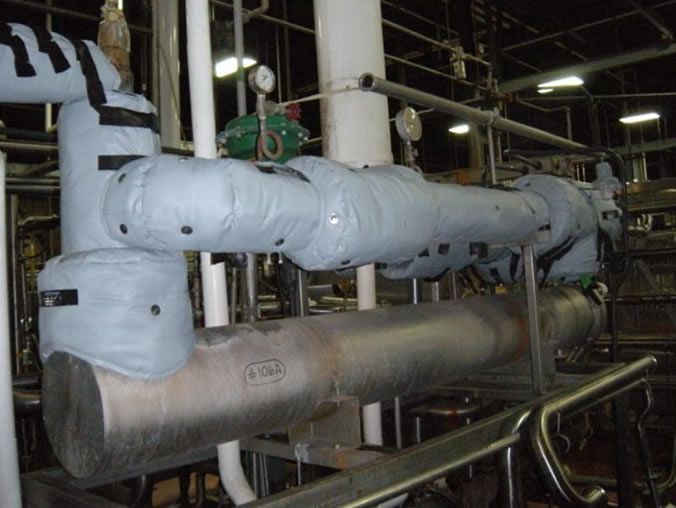NON-FIBROUS BLANKET – FOOD GRADE APPLICATIONS
LT300LFP-EF (LT149C-LFP-EF)
INTRODUCTION
Shannon Thermal Blankets are a custom fit high quality engineered insulation system designed to save energy, retain radiant heat, minimize insulation maintenance and improve the surrounding work environment. Shannon is designed for use in the Food Processing Industry, where a Non-Porous, NonFibrous, vapor barrier blanket system can be chemically sanitized, Sanitary Wash-Down. The PTFE Teflon® Film Jacketing Complies with the Regulations of the FDA – Reference 21 CFR 177.1550 Standards for Components of Articles Intended to come in Direct Contact with Food. Shannon is flexible and easy to install, remove and reinstall allowing easy access to surfaces.
Applications: Sanitary – “Non-Fibrous” Requirement
Steam Process Piping, Gate Valves, Condensate Pumps, Pasteurizers, Pressure Reducing Valves, Control Valves, Heat Exchangers and Strainers.
Markets:
Food Processing Industry
Food Handling Industry and Institutional Utility Steam Distribution sites.
Service Temperature/Condition
This design is to act as a Thermal Barrier with a maximum service temperature of 300˚F (149˚C).
Product Components
The Outer and Inner Jacketing is a 13.5 oz/yd² (459 g/m²) 100 percent PTFE CrossFilm® Laminate. The Insulation Core consists of Aerocel® EPDM Elastomeric Closed Cell Foam Insulation. Aerocel®, Type 1, EF Insulation will be encapsulated by the inner and outer jacketing, with a double sewn construction, producing a Self-Contained Blanket Insulation System. The design includes Integral Fasteners for install & removal.

Steam Supply Control Valve Station – Steam Pasteurizer
BLANKET THICKNESS SURFACE TEMPERATURE REFERENCE
Operating Temp |
Thickness |
Surface Temp |
Thickness |
Surface Temp |
Thickness |
Surface Temp |
|---|---|---|---|---|---|---|
| 121˚ C (250˚ F) | 25 mm( 1″) | 37.9˚ C (100.2˚ F) | 40 mm( 1.5″) | 33.3˚ C (92.0˚ F) | 50 mm (2″) | 30.8˚ C (87.4˚ F) |
| 149˚ C (300˚ F) | 25 mm( 1″) | 42.6˚ C (108.6˚ F) | 40 mm( 1.5″) | 36.8˚ C (98.2˚ F) | 50 mm (2″) | 33.5˚ C (92.3˚ F) |
* The above referenced Cold Face Surface Temperatures should be used as guidelines for blanket insulation thickness design.
* The Cold Face Surface Temperature of the blanket should approach surrounding ambient temperature conditions.
* The economic thickness of the blanket should consider blanket cost, thermal performance and blanket design constraints.
* Heat loss calculations are based on a 21.1˚ C (70˚ F) ambient temperature using a flat surface condition.
